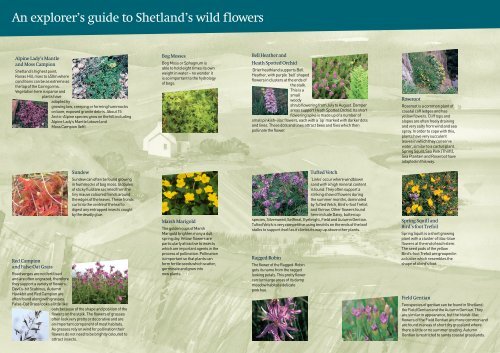Wild Flowers leaflet - Shetland Heritage
Wild Flowers leaflet - Shetland Heritage
Wild Flowers leaflet - Shetland Heritage
You also want an ePaper? Increase the reach of your titles
YUMPU automatically turns print PDFs into web optimized ePapers that Google loves.
An explorer’s guide to <strong>Shetland</strong>’s wild flowers<br />
Alpine Lady’s Mantle<br />
and Moss Campion<br />
<strong>Shetland</strong>’s highest point,<br />
Ronas Hill, rises to 450m where<br />
conditions can be as extreme as<br />
the top of the Cairngorms.<br />
Vegetation here is sparse and<br />
plants have<br />
adapted by<br />
growing low, creeping or forming hummocks<br />
on bare, exposed granite debris. About 15<br />
Arctic-Alpine species grow on the hill including<br />
Alpine Lady’s Mantle (above) and<br />
Moss Campion (left).<br />
Sundew<br />
Sundew can often be found growing<br />
in hummocks of bog moss. Globules<br />
of sticky fluid are secreted from the<br />
tiny mauve coloured fronds around<br />
the edges of the leaves. These fronds<br />
curl into the centre of the leaf to<br />
digest any entrapped insects caught<br />
by the deadly glue.<br />
Red Campion<br />
and False-Oat Grass<br />
Road verges are not fertilised<br />
and are often ungrazed, therefore<br />
they support a variety of flowers.<br />
Devil’s-bit Scabious, Autumn<br />
Hawkbit and Red Campion are<br />
often found along with grasses.<br />
False-Oat Grass looks a little like<br />
oats because of the shape and position of the<br />
flowers on the stalk. The flowers of grasses<br />
often look very pretty or decorative and are<br />
an important component of most habitats.<br />
As grasses rely on wind for pollination their<br />
flowers do not need to be brightly coloured to<br />
attract insects.<br />
Bog Mosses<br />
Bog Moss or Sphagnum is<br />
able to hold eight times its own<br />
weight in water – no wonder it<br />
is so important to the hydrology<br />
of bogs.<br />
Marsh Marigold<br />
The golden cups of Marsh<br />
Marigold brighten many a dull<br />
spring day. Yellow flowers are<br />
particularly attractive to insects<br />
which are important agents in the<br />
process of pollination. Pollination<br />
is important so that plants can<br />
form fertile seeds which scatter,<br />
germinate and grow into<br />
new plants.<br />
Bell Heather and<br />
Heath Spotted Orchid<br />
Drier heathland supports Bell<br />
Heather, with purple ‘bell’ shaped<br />
flowers in clusters at the ends of<br />
the stalk.<br />
This is a<br />
small<br />
woody<br />
shrub flowering from July to August. Damper<br />
areas support Heath Spotted Orchid. Its short<br />
flowering spike is made up of a number of<br />
small pinkish-lilac flowers, each with a ‘lip’ marked with darker dots<br />
and lines. These dots and lines attract bees and flies which then<br />
pollinate the flower.<br />
Tufted Vetch<br />
‘Links’ occur where windblown<br />
sand with a high mineral content<br />
is found. They often support a<br />
striking show of flowers during<br />
the summer months, dominated<br />
by Tufted Vetch, Bird’s-foot Trefoil<br />
and Yarrow. Other flowers found<br />
here include Daisy, buttercup<br />
species, Silverweed, Selfheal, Eyebright, Field and Autumn Gentian.<br />
Tufted Vetch is very competitive using tendrils on the ends of the leaf<br />
stalks to support itself as it climbs its way up above other plants.<br />
Ragged-Robin<br />
The flower of the Ragged-Robin<br />
gets its name from the ragged<br />
looking petals. This pretty flower<br />
can turn large areas of its damp<br />
meadow habitat a delicate<br />
pink hue.<br />
Roseroot<br />
Roseroot is a common plant of<br />
coastal cliff ledges and has<br />
yellow flowers. Cliff tops and<br />
slopes are often freely draining<br />
and very salty from wind and sea<br />
spray. In order to cope with this,<br />
plants have very succulent<br />
leaves in which they conserve<br />
water, similar to a cactus plant.<br />
Spring Squill, Sea Pink (Thrift),<br />
Sea Plantain and Roseroot have<br />
adapted in this way.<br />
Spring Squill and<br />
Bird’s-foot Trefoil<br />
Spring Squill is a short growing<br />
plant with a cluster of lilac-blue<br />
flowers at the end of each stem.<br />
The seed pods of the yellow<br />
Bird’s-foot Trefoil are grouped in<br />
a cluster which resembles the<br />
shape of a bird’s foot.<br />
Field Gentian<br />
Two species of gentian can be found in <strong>Shetland</strong>;<br />
the Field Gentian and the Autumn Gentian. They<br />
are similar in appearance, but the bluish-lilac<br />
flowers of the Field Gentian are more common and<br />
are found in areas of short dry grassland where<br />
there is little or no summer grazing. Autumn<br />
Gentian is restricted to sandy coastal grasslands.


